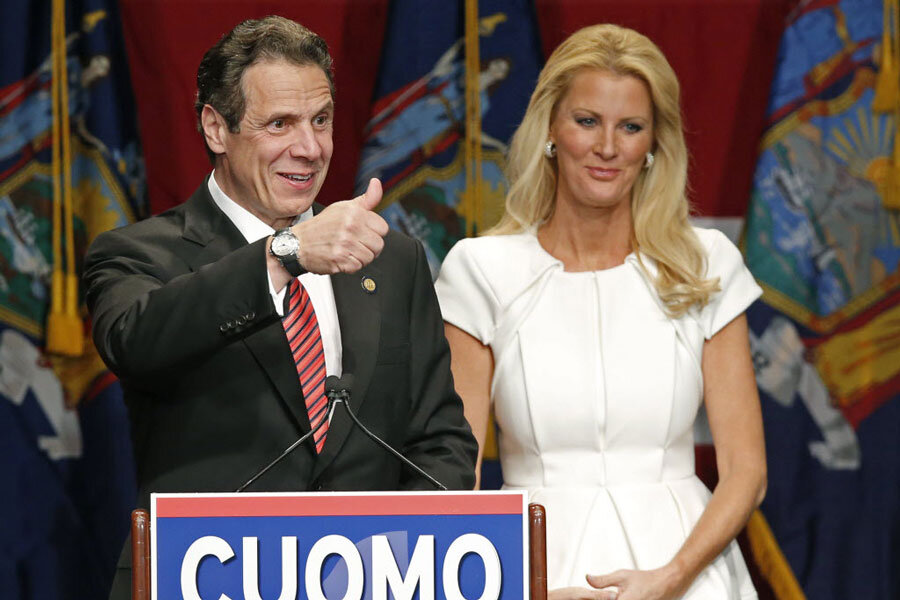Why New York's Democratic governor may prefer a Republican state Senate
Loading...
| New York
As part of the Republican wave that swept across the country Tuesday, reaching even into blue-state bastions in the Northeast, the GOP also solidified its control of the New York State Senate.
And for Democratic Gov. Andrew Cuomo, this probably suits him just fine.
After all, the wily centrist New York governor, who easily defeated his Republican challenger Tuesday and is considered by many to have an eye on the White House, hardly campaigned for state Senate candidates – making it difficult for fellow Democrats to grab hold of his proverbial coattails.
And his barely tepid support for his party, even leading up to his own landslide reelection Tuesday, underscored again how Governor Cuomo has meticulously, and cleverly, held Democrats in check as he governs with the kind of fiscally conservative policies that drive New York liberals bonkers.
“I think that’s what he wanted, and what he preferred,” says Ken Sherrill, professor emeritus of political science at Hunter College in Manhattan. “He certainly never wanted to deal with Democratic majorities in both houses, because they would have wanted to spend more money than he wanted to spend."
It's the kind of centrism that could play well in so-called purple states, and after the carnage of Tuesday’s election, Democrats find themselves with fewer governors on the bench as viable presidential nominees.
Should Hillary Rodham Clinton somehow falter – or even happen not to run, unlikely as that appears to be – Cuomo could make a strong case as a governor who works well with Republicans while also keeping progressive Democrats in check.
“You have wild liberals, you have ultraconservatives,” he said during the campaign this fall. “My job is to figure how to work with them, and figure out how to get all of them to a place where they’re satisfied or they have a win.”
Yet at the same time, Cuomo has demonstrated a masterful political touch in passing major liberal legislation. In 2011, he worked behind the scenes to garner support for gay marriage, quietly appealing to Wall Street donors to help put pressure on a few Republicans to support the measure. The governor worked swiftly, and when the bill passed, New York’s law helped spark momentum for gay marriage nationwide.
And after the Sandy Hook shootings in 2012, Cuomo was able to push through one of the most restrictive gun laws in country – efforts that failed nationally and in most US states – coaxing enough Republican state senators to support the measure, despite intense opposition from conservatives and the National Rifle Association.
Despite these liberal bona fides, a significant number of New York Democrats remain bitter with what they see as fiscal stinginess. This led to a somewhat embarrassing revolt in the primaries, when a little-known law professor, Zephyr Teachout, garnered more than 30 percent of the vote with barely a buck in the bank.
Yet even as Cuomo strong-arms liberals and cultivates conservative support, he has hardly built up the kind of political capital and grassroots party support required for national office, observers say.
“I’m sure politicians have ambitions, but it’s hard to think of Cuomo as a viable candidate for higher office,” says Professor Sherrill. “And I also think that after this campaign, there may not be the kind of rank-and-file and middle leadership support for him. He offered no coattails, he didn’t help any Democrats get elected – you’d have no rational expectation that he would be there for you in any campaign.”
And unlike his gregarious centrist counterpart in New Jersey, Gov. Chris Christie, who earned heaps of political capital this election cycle by criss-crossing the country and helping elect fellow Republican governors, Cuomo is somewhat gruff and cold on the stump.
“It’s inconceivable that he could do the kind of retail politics that you need to get through New Hampshire and Iowa,” Sherrill says. “That would really require a different personality, which he doesn’t have.”






